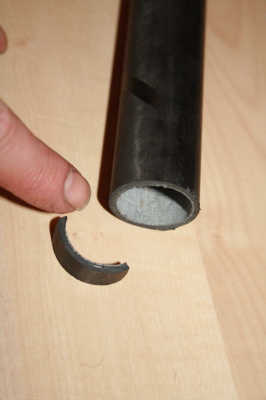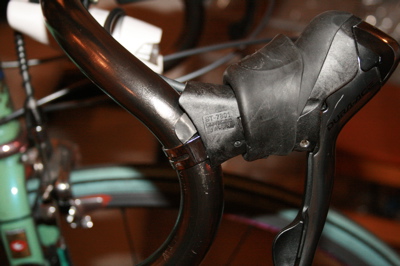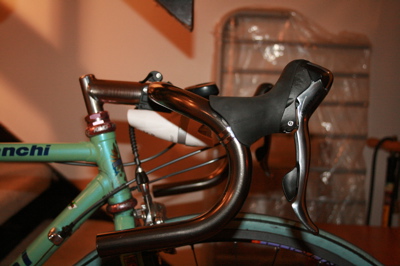In part 1 of this series, I described how dropbar design had changed with the evolution of lever shape. In particular, I wanted to mount a newer integrated brake/shift lever with an older dropbar, yet mimic the flat ramp-to-lever transtion of newer handlebar designs. I’ve come up with a trick to do this. Basically I fashion a shim that fits on top of the lever clamp band, between the lever body and the bar. After experimenting with several different materials, I’ve settle on using scraps of 1-1/8” carbon fork steerers. The inner diameter is a close match to the handlebar, while the thickness is adequate to make a noticeable difference to the fit of the lever body. The carbon is pretty easy to hacksaw and file, though the carbon dust is pretty bad for you. Minimize skin contact and don’t breathe it in.

First you cut a 1cm ring of carbon steerer. From that you’ll need to fashion two shims that are both a little less half the circumference of your original cut. The shims should be just a little wider than the lever body. Then you should round the top corners so you don’t feel them while riding on the hoods. Next you’ll need to decide where to put your levers on the dropbar’s curve.

The photo above shows the lever body(without shim) mounted with the common method of lever tip in line with the lower handlebar run. A lot of riders like this set-up, but I find that angle that the bar meets the lever body is somewhat uncomfortable while the reach to the lever from the drop is longer than ideal for my hands’ reach.

The photo above shows the lever body(also without shim) moved down the drop so that the line from the bar’s ramp to the lever body is smooth. If the entire bar is rotated up in the stem, then the reach to the lever is actually quite good, but I don’t like that much tilt up on my bars.
Below, I’ve placed the shim on top of the lever body’s mounting band. Actually, the shim isn’t quite directly behind the lever body; if you don’t hold the lever body steady while you’re tightening the fixing nut, the shim may shift on you. I’ll have to loosen the lever and try again.

In the final photo, I’ve positioned the shimmed lever body high on the drop’s curve. The shim tilts the lever body down, simultaneously flattening the ramp-to-lever transition and improving the reach to the lever from the drops. Yet the bar has just a slight tilt up. Exactly how I wanted it. The difference is visually subtle enough that you’ll have to compare it to the photos above to see it, but I can definitely feel the difference while riding.

On my own bikes I’ve tried this technique with both Shimano STI and SRAM (early gen RIval without built in lever reach adjustment), and it worked well. I’ve done it on a few customers’ bikes with similar success. However, since the newest versions of STI and Double Tap have reach adjustment of the lever, I’m not sure there will be many instances calling for shims. Ironically Campagnolo’s new Ergopower levers use a shim to increase reach. The Campag shim snaps into the back of the lever below the clamp band, thereby tilting the whole lever body up and increasing the reach to the lever
…We're riding townies, adventure, and mountain bikes. Find recommendations on our store page. As Amazon Associates we earn from qualifying purchases.